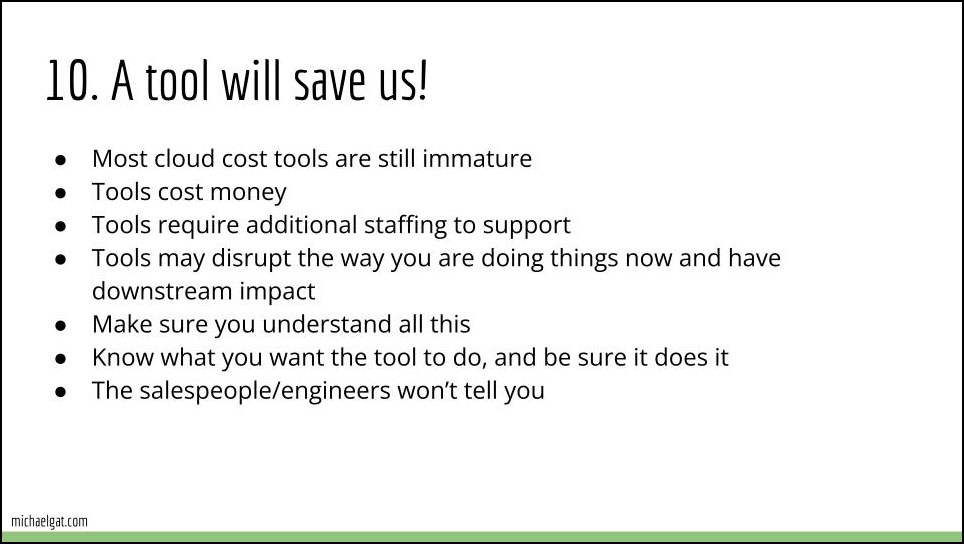Anti-Patterns in Tech Cost Management: “A tool will solve the problem!”
Series Index
Introduction
Anti-Pattern 1: Not considering scale
Anti-Pattern 2: Bad cloud strategy
Anti-Pattern 3: Inability to assign/attribute costs
Anti-Pattern 4: No metrics or bad metrics
Anti-Pattern 5: Not designing it in
Anti-Pattern 6: Cost management as a standalone
Anti-Pattern 7/8: No ongoing reviews (current and potential)
Anti-Pattern 9: Across the board cuts
Anti-Pattern 10: “A tool will solve the problem!”
Anti-Pattern Bonus: Don’t do rewards programs!
A few thoughts: Three things you can do right now, for yourself and your team
Wrap up

Today’s anti-pattern is common, and not just in the cost management space. It is the assumption that there’s a tool out there that is so magical, it will absolve you of the need to actually figure things out and understand what you’re doing. There is a strong interest in this space right now, and in the previous two times I’ve given versions of this talk, “what tool should I use?” has been the most common question I’ve received.
I’ll lead with my bias: I strongly believe that if you can’t do something manually, no tool will help. It may, in some way, make you feel better. It may even “jump start” you, but it will do so in a way that ensures you are confused down the road and probably will make some serious mistakes in setting things up.
The biggest problem with tech costing tools is that it’s a relatively immature space. There are a lot of new tools that have popped up in the past year or two, mostly focused on AWS and to some degree on the other big public cloud providers. They focus on different problems (everything from managing tagging/attribution) to helping with instance selection, and the quality is variable. This isn’t a knock on any of them, as noted, it’s just an immature space and it remains to be seen what will shake out.
Beyond that, the things to beware of are the same things you should beware of when adding any new tool: they cost money, require time, may force you to change processes that currently work just fine, and can generally disrupt things. You really need to have a clear use-case and understand how the tool does and doesn’t suit it. No tool is ever perfect, so be prepared for that. The sales engineers will not tell you the downsides so you need to figure them out yourself.
Join us at the SoCal Linux Expo (SCaLE 21x) in Pasadena on March 14-17. My talk will be on Saturday the 16th. I will also be speaking at UpSCaLE on Friday night, and running the Observability track on Saturday and Sunday.
It’s $90 for four days of great content. (If you know me, ping me as I may have a few discount passes left.)